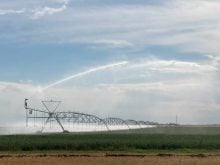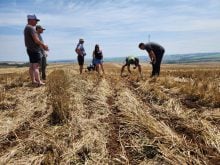Management practices that prevent the disease are not available, nor is resistance in Canadian cereal crops
Gursahib Singh of the Irrigation Crop Diversification Corporation issued a warning to Saskatchewan irrigators: look out for bacterial leaf streak.
The research director of ICDC presented to 200 members of the irrigation industry at the Irrigation Saskatchewan conference held Dec. 5 in Saskatoon.
Bacterial Leaf Streak is so far not a problem in Saskatchewan, but has been a growing problem in Alberta and the United States for a decade.
The air- and seed-borne pathogen is mostly seen in irrigated crops. No management practices are readily on-hand to deal with the disease and crop resistance is not available for Canadian cereal crops. Bactericides, copper, and seed treatments do not have an effect, said Singh.
Read Also

Why feds imposed EV tariffs
Moe and Kinew have a fight on their hands when it comes to eliminating the EV tariff. Canada has to worry about pissing off the U.S. and Mexico and hundreds of thousands of auto workers.
Leaf streak often gets misdiagnosed and when farmers see it as a fungal infection, the fungicide isn’t going to help, he said.
“You are killing all the other saprophytes or other pathogens, and there is no competition left. You’re not killing bacteria. They’re the pathogen that is left and you are giving them every opportunity to invade the leaves or the crop.”
This increase in cases is a new thing, so Saskatchewan researchers are yet to start extensive research, Singh said, but they are learning from researchers in Alberta and the U.S.
He and professor Randy Kutcher at the University of Saskatchewan are monitoring whether the problem could cross into the province, while he noted Thomas Kelly Turkington, plant pathologist with the Agriculture Canada Research and Development Centre in Lacombe, Alta., and Michael Harding, crop health assurance lead for Alberta Agriculture and Irrigation, are the leading experts on the disease in Alberta.
Minor cases of bacterial leaf streak have been recorded on the Prairies since 1920, but never as severe as what is occurring now, said Harding. Strong annual increases of the disease have created economic losses in the Midwest and U.S. Great Plains in about 2012 and in 2015.
Southern Alberta irrigators starting noticing it in 2015, said Harding.
Three factors have to be ideal for the disease to thrive: the pathogen must be present with a susceptible host and the perfect weather conditions, and the potential is there for the problem to continue to grow, he said.
“Depending on those three sides of the disease triangle, that’s really going to determine what happens but based on what we’ve seen happen in North America so far, it wouldn’t be that surprising if the disease became more prevalent and more severe in more fields across the Prairies.”
All wheat and barley crops grown on the prairies are “extremely or fairly susceptible,” he said, but drought conditions have slowed the spread of disease. However, irrigation creates the proper moisture conditions for both growth and spread of the disease in these grass and cereal crops.
Spreading information on what to look for with the infection has been important for the Alberta irrigation community. Seeing spots on leaves during scouting, most farmers diagnose the problem as cereal leaf spot, and often they’re correct. This is why misdiagnoses are prevalent; farmers don’t expect it in their fields.
With bacterial leaf streak, there are telltale signs, including a lesion on the third leaf down the midrib turning from yellow to a heavy bacterial ooze and black chafe on the head.
Letting the canopy dry between irrigation events can slow the spread of the disease, but crops need water, so if it’s a toss-up between spreading the disease or making sure their crops have adequate water, Harding said they are going to lose more yields from not enough water than they ever could from the leaf streak.
The best management practice that farmers have now is proper crop rotations, he said.
“If you can get a hold of seed that has little or non-detectable levels of bacteria, and you’ve got a two- to three-year break between cereal crops, you’re probably going to be breaking the cycle enough that this isn’t going to be a consistent problem.”
No specific cultivar has built up resistance or tolerance to the disease, but Harding said work has begun on identifying the strains breeders can work with.
“We don’t really have a good answer for what cultivars have higher tolerance to this or what are more susceptible… that work has started and we will over time have those answers.”















